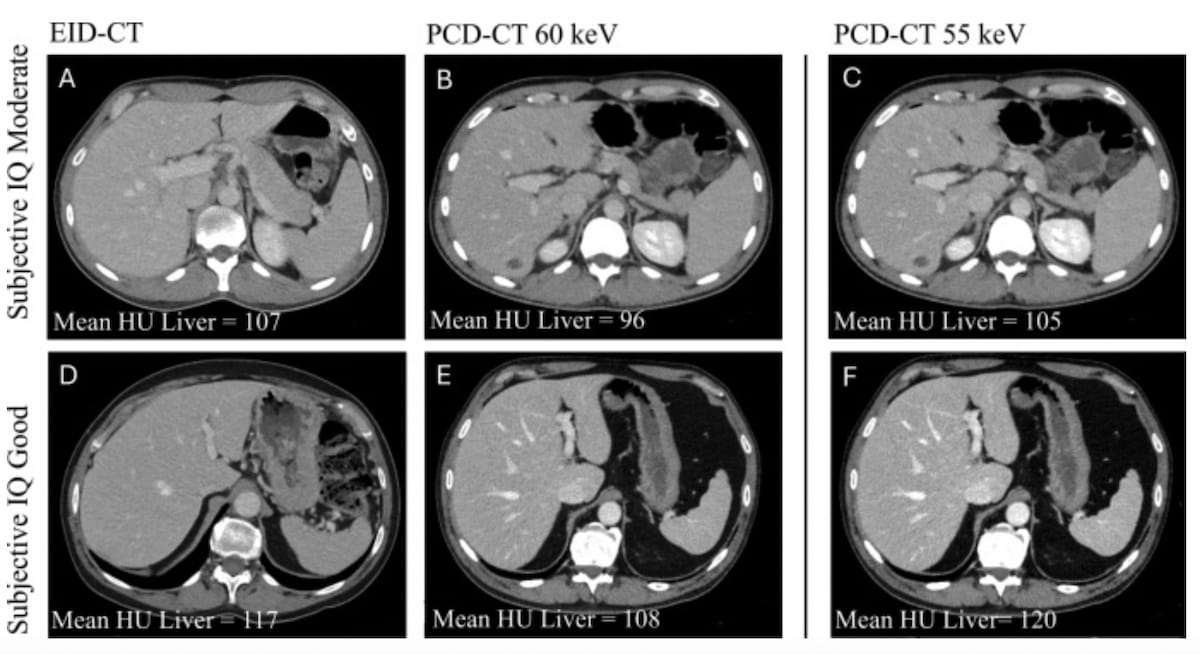For abdominal computed tomography (CT) scans, emerging research reveals that photon counting CT offers a combination of enhanced image quality and a 20 percent reduction in iodinated contrast medium in comparison to energy-integrating detector CT (EID-CT).
For the retrospective study, recently published in the European Journal of Radiology, researchers compared 102 portal venous phase (PVP) abdominal CT scans obtained with photon counting detector-CT (PCD-CT) to 91 PVP scans obtained via a total body weight (TBW)-adapted EID-CT protocol.1
The study authors found that PCD-CT facilitated a 20.1 percent reduction in total iodine load (TIL) in comparison to EID-CT. The use of PCD-CT also achieved significant increases in the signal-to-noise ratio (SNR) in the liver (9.9 vs. 9.1) as well as the contrast-to-noise ratio (CNR) (5.1 vs. 4.3), according to the researchers.1
“This study shows that a PCD-CT allows CM (contrast media) dose reduction in abdominal PVP CT scans, compared to an EID-CT, both with an optimized CM protocol, while maintaining sufficient diagnostic (image quality),” wrote lead study author Eva J.I. Hoeijmakers, M.D., who is affiliated with the Department of Radiology and Nuclear Medicine at Maastricht University Medical Center in Maastricht, the Netherlands, and colleagues.
Employing a vendor-recommended virtual monoenergetic image (VMI) level of 60 keV, the researchers found that PCD-CT demonstrated a mean CT attenuation of 111 HU in comparison to 120 HU for EID-CT. However, the study authors also noted the potential of combining the higher iodine CNR of PCT-CT with low-energy VMI for image reconstruction.1
“Secondary analysis of the PCD-CT scans reconstructed at 55 keV showed a mean CT attenuation in the liver of 120 ± 17 HU, which was not significantly different from the EID-CT scans,” added Hoeijmakers and colleagues.
Three Key Takeaways
1. Contrast media reduction. Photon counting detector-CT (PCD-CT) allows for a 20 percent reduction in iodinated contrast medium compared to energy-integrating detector-CT (EID-CT), while still maintaining sufficient diagnostic image quality.
2. Improved image quality. PCD-CT offers enhanced image quality with higher signal-to-noise ratio (SNR) and contrast-to-noise ratio (CNR) in the liver compared to EID-CT.
3. Radiation dosing considerations. Although PCD-CT offers benefits in contrast media reduction and image quality, it was associated with a slightly higher radiation dose compared to EID-CT in this study.
While other recent research examining PCD-CT and EID-CT has demonstrated greater reductions of CM, ranging from 27 to 50 percent, the study authors pointed out that one of the studies only utilized 120 kV scans for EID-CT with smaller CNR and SNR differences.2,3 The researchers said another study limited cohort inclusion to overweight and obese individuals.3
“The present study is unique by using individualized kV-adapted (contrast media) protocols for EID-CT as basis for comparison with PCD-CT,” emphasized Hoeijmakers and colleagues.
(Editor’s note: For related content, see “Study: Photon Counting CT Reduces Radiation Exposure by 44 Percent for Kidney Stone Detection,” “Could Photon Counting CT Supplant MRI for Imaging Assessment of Hepatic Steatosis?” and “Computed Tomography Insights on GI Bleeding: Nine Takeaways from New Consensus Recommendations.”)
Beyond the inherent limitations of a retrospective single-center study, the authors acknowledged a higher radiation dose for PCD-CT (7.4 mGy CTDlvol versus 6.5 mGy CTDlvol) in comparison to EID-CT. They also noted different slice thicknesses prevented SNR and CNR assessments for 55 keV reconstructions.
References
1. Hoeijmakers EJI, Stammen L, Wildberger JE, et al. PCD-CT enables contrast media reduction in andominal imaging compared to an individualized kV-adapted contrast media injection protocol on EID-CT. Eur J Radiol. 2024;179(111680). doi: 10:1016/j.ejrad.2024.111680.
2. Layer YC, Isaak A, Mesropyan N, et al. Image quality of abdominal photon-counting CT with reduced contrast media dose: evaluation of reduced contrast media protocols during the COVID19 pandemic supply shortage. Heliyon. 2024;10(6):e28142.
3. Hagen F, Estler A, Hofmann J, et al. Reduced versus standard dose contrast volume for contrast-enhanced abdominal CT in overweight and obese patients using photon counting detector technology vs. second-generation dual-source energy integrating detector CT. Eur J Radiol. 2023 Dec:169:111153. doi: 10.1016/j.ejrad.2023.111153.
